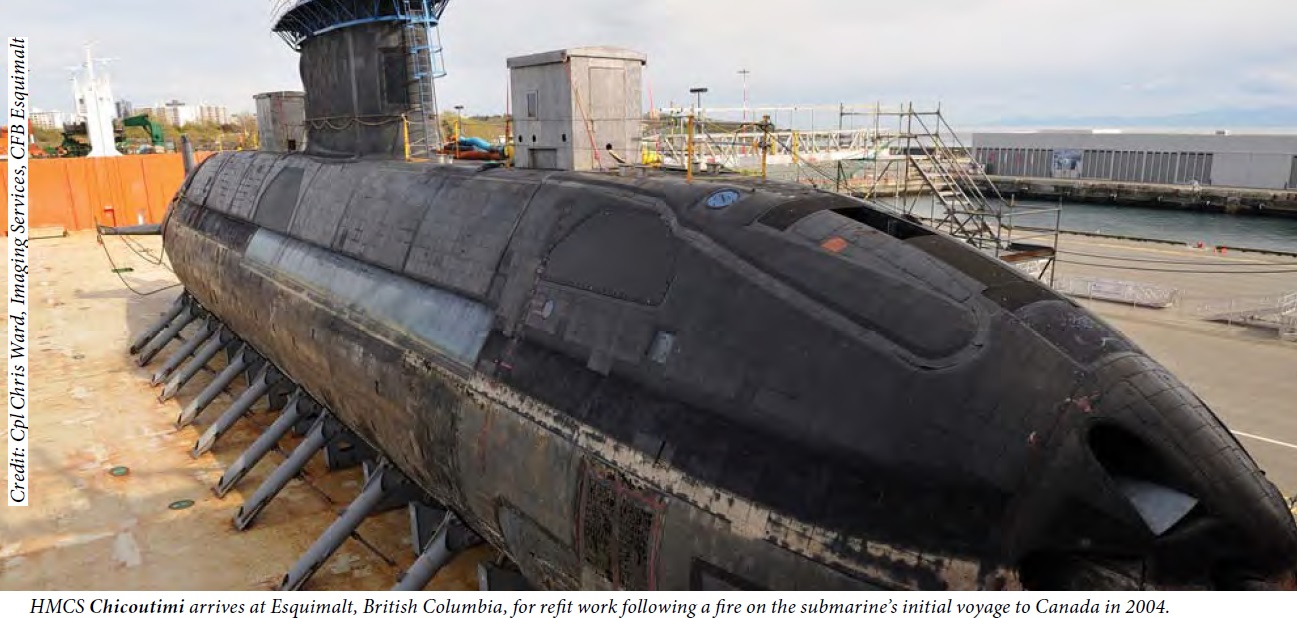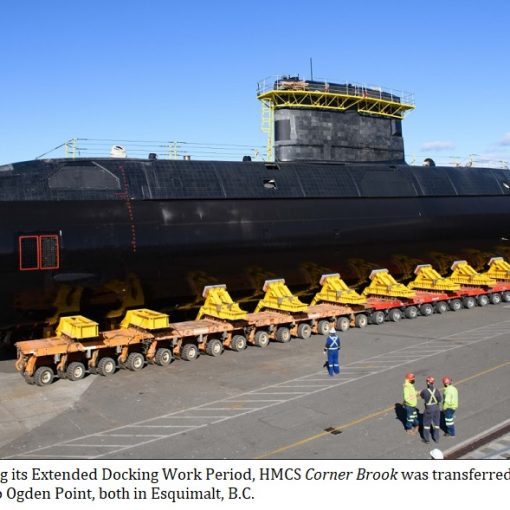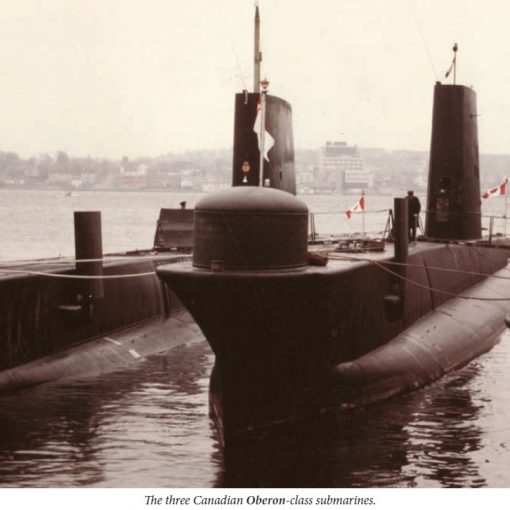*Moderator’s Note: This article was originally published in Defence and Technology India, Vol. 30, No. 3 (December, 2007): 14-16. It is reprinted here with the permission of the author. Prof. Ram teaches Military History at American Military University in West Virginia. He is a member of the Royal Canadian Military Institute’s Defence Studies Committee and sits on the Canadian Council for Security in the 21st Century. He is a former Canadian Army officer.
At approximately 10:00 am EST on 05 October 2004, a fire broke out on board HMCS Chicoutimi, Canada ‘newest’ submarine. The result was the boat was gutted by fire, left powerless and rolling on high seas in the mid-Atlantic, with nine crew members injured, one of whom, Lt.(N) Chris Saunders, eventually died.
The real question behind this tragedy belies the serious problems within the Canadian Forces (CF), but it also highlights the inept and stupid policy decisions made at the highest levels in Ottawa regarding the state of defence and security for Canada. Therefore, it is worthwhile to review the history of the “new” submarine fleet for Canada to understand the larger issues that have essentially destroyed the military capability of the Canadian Forces as a whole.
The ‘Chicoutimi Story’ begins over a decade and a half ago. In the waning days of the Cold War, the Royal Navy (RN) began launching its new Upholder (Type 2400) submarine class. Built by Vickers Shipbuilding, the four submarines (HMS Upholder, Ursula, Unseen, and Unicorn) in the class were launched between the late 1980s and early 1990s. However, due to a 1993 government defence review, RN cutbacks dictated that either the four Upholders were retained and the navy would lose two nuclear attack boats, or the Upholders could be decommissioned. It was decided that the RN’s submarines would be limited to an all-nuclear powered force, thus making the four diesel-electric Upholder-class boats redundant. They were decommissioned in 1994. Over the next few years a number of countries, including South Africa, Canada and Australia, looked at buying or leasing the boats.
The boats lay idle until 1999, when a recommissioning and refit process began to turn the boats over to the Canadian navy. In 1998, after years of internal wrangling between the Canadian government, its Department of National Defence (DND) and the navy, it was decided to ‘lease’ the boats for Canadian service. The primary objective was to replace its three old and obsolete British built Oberon-class of boats, HMCS Ojibwa, Onondaga and Okanagan.
The basic deal called for the boats to be sold/leased for Can$750 million (£226 million). This cost in theory would be offset by Canada providing existing leasing arrangements in Canada for army and air force training facilities at no cost to the MoD. The purchase/lease cost included the re-commissioning and refit (by Marconi Marine, the then-owners of Vickers Shipbuilding and Engineering) of all four boats and training of Canadian sailors. The Upholder-class was renamed by Canada as the Victoria-class.
On first glance this seemed like a great deal for Canada, four “slightly used” submarines for the price of one with a cheaper operating cost than new subs. As the Canadian navy planners noted, “The cost of these submarines, relative to that projected for the acquisition of new boats – $3B to $5B – established a significant margin for value.” Also the boats once upgraded and “Canadianised” would supposedly be 21st-century machines. Yet, here lay the origins of the disaster that killed Lt. Saunders.
What is immediately obvious is that the hulls were anywhere from 15 to 20 years old before they reached Canadian service. These boats were replacing 30 plus year-old Oberon’s. It's hard to believe that the navy could have misjudged the timing so badly, as at best the Upholder/Victoria-class might have had a maximum life of only 30 years. By the time they came into service, at best they might have 10 to 15 years of life left in them. This was reflected in the Canadian navy’s mid-life refit, scheduled for 2010.
Two issues that impacted the above chronology were the condition of the boats during
RN service and problems surrounding the refit process.
On entering service it was found that HMS Upholder had a serious defect with its torpedo system (the Weapons Handling and Discharge System - WHDS). In short, the boats could not fire their torpedoes. In 1992, £9 million was spent to fix this problem on Upholder, Ursula and Unseen. Unicorn was still under construction and the refit was done during the final construction phase.
Another critical problem that occurred was the electrical wiring in the boats was not sufficient. The RN upgraded the wiring in Ursula, Unseen and Unicorn during construction; however, Upholder/Chicoutimi had already put to sea and was not upgraded with the additional two layers of sealant that provided “backup protection” to the wiring assemblage.
What is more troubling about the timeline is the number of years the subs spent mothballed. Chicoutimi spent some nine years sitting in seawater, while the other boats were from four to six years, from sale to delivery. Canadian navy inspections revealed almost immediately that three of the boats had welding defects in the high-pressure air pipe system that pumped air into the ballast tanks – the system that allows the boat to surface. Also the submarines’ escape hatches were missing a critical part, which was required so that rescue craft could attach to the submarines.
Also DND noted that the scrubbers in the air-quality system were inadequate as carbon dioxide (CO2) would reach unacceptable levels within 12 hours. There were a litany of other maintenance difficulties and mechanical problems that came with trying to re-start machinery and electronics that have been idle for a number of years:
- HMCS Corner Brook, during its sea-trials off the coast of Scotland, took on some 1500 litres of seawater due to malfunctioning Submerged Signal Ejector (SSE). These tubes are used to launch acoustic or bubble countermeasure decoys while submerged.
- Corner Brook suffered a second accidental flooding causing an emergency surfacing off Nova Scotia.
- There was a hull dent about the size of a medium pizza under an acoustic tile on Victoria that required fixing (cost Can$400,000). The dent limited Victoria to 75 percent of its 200-metre diving depth.
- All the boats had cracks on their exhaust values. These valves are the main paths for engine exhaust to escape from the submarines diesel engine through the pressure hull. Failure of a value could sink the boat.
- In 2002, HMCS Windsor left Halifax for a planned two-week mission, but was forced to turn back after approximately 2000 litres of sea water seeped into a hydraulic motor.
- In the case of Chicoutimi, it was discovered that the hull was corroded beyond its safe operating limit. In addition the air turbine pumps were defective and the hull valves were cracked. Even worse, Chicoutimi had been cannibalised for parts for HMCS Corner Brook, in an effort to meet the slipping delivery deadlines.
Now it is clear that any new naval platform has its teething problems, but the Upholder-class was already ‘old’ by the time Canada decided to take the four boats. The events surrounding the ‘Chicoutimi Tragedy’ merely underscored the failure of the government and the navy not only to protect the interests of Canada, but that of its able sailors.
The cause of the fire in Chicoutimi was clearly preventable, however, the need to bring the now lagging program back on track required that the boat be pressed into service with the Canadian navy. A mere twenty-four hours into the ship’s maiden voyage under a Canadian flag, the crew was forced to leave two hatches open to fix an air vent in Chicoutimi’s conning tower. This occurred because a small nut had fallen off at some point - being unable to close the vent prevented the boat from submerging. While on the surface during rough seas a wave broke over Chicoutimi sending seawater into the innards of the boat. This triggered a series of electrical shorts (due to the sub-standard wire coating) in the Captain’s quarters, which led to the major fire. Chicoutimi also suffered a second minor fire in one of its oxygen generators.
Almost immediately senior Canadian naval commanders and their civilian counterparts in DND indicated that the fire was “minor” and that nine crewmembers had suffered smoke inhalation, but there are were injuries. The next day, 06 October, the navy was forced to admit it had understated what had happened and called the event a “major” fire causing “extensive damage to cabling.” The navy also announced that Lt. Saunders had died.
The Canadian and British naval brass immediately tried to cover themselves by stating that the sub was not the problem, which then implied that the fault must have been due to human error on part of the crew. The initial findings of the subsequent investigation has proved that the crew was not to blame, and had it not been for their actions the boat would have been lost with possibly many more casualties. The Canadian navy then placed a gag order on the sailors and officers of Chicoutimi in order to stop them from revealing the truth about the condition of the boat.
In July 2002, Chief of the Maritime Staff Vice-Admiral Ron Buck wrote, “The Navy’s safety record, with regard to operating submarines, is unblemished. The key thing for us is that when we accept these submarines on behalf of Canada, is that they must be safe for our submariners to operate. We do not cut safety corners.”
This statement by Vice-Admiral Buck epitomizes the careerism and bureaucratic nature of the command structure within the CF. It was clear that, even in 2002, the Victoria-class submarines had serious problems. The events surrounding the fire on Chicoutimi and all the other mishaps onboard the other boats simply contradict any statements made by senior naval commanders.
The purchase of the Victoria-class merely underscores the larger endemic problems of an unclear defence policy, under funding, rust out, officer bloat and senior command careerism that has essentially gutted the CF military capabilities over the past three decades. Lt. Saunders pointless death is one in a list of many that belies the reality that Canada can no longer defend itself or aid its allies.






One thought on “Four submarines and a funeral*”